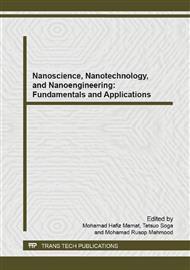[1]
J. Bundschuh and G. Chen, Sustainable Energy Solutions in Agriculture: CRC Press, 2014.
Google Scholar
[2]
Nugroho Dewayanto, Ruzinah Isha, Mohd Ridzuan Nordin, Use of palm oil decanter cake as a new substrate for the production of bio-oil by vacuum pyrolysis, Energy Conversion and Management 86 (2014) 226-232.
DOI: 10.1016/j.enconman.2014.04.078
Google Scholar
[3]
J. G. Buijnsters, M. Camero, L. Vázquez, F. Agulló-Rueda, C. Gómez-Aleixandre, and J. Albella, DC substrate bias effects on the physical properties of hydrogenated amorphous carbon films grown by plasma-assisted chemical vapour deposition 81 (2007) 1412-1415.
DOI: 10.1016/j.vacuum.2007.04.021
Google Scholar
[4]
C. Casiraghi, F. Piazza, A. Ferrari, D. Grambole, and J. Robertson, Bonding in hydrogenated diamond-like carbon by Raman spectroscopy, Diamond and Related Materials 14 (2005) 1098 1102.
DOI: 10.1016/j.diamond.2004.10.030
Google Scholar
[5]
J. E. Butler and A. V. Sumant, The CVD of nanodiamond materials, Chemical Vapor Deposition 14 (2008) 145-160.
DOI: 10.1002/cvde.200700037
Google Scholar
[6]
H. Dai, Y. Zhang, Z. Chen, and F. Zhai, Investigating the structural and physical properties of hydrogenated amorphous carbon films fabricated by middle frequency pulsed unbalanced magnetron sputtering, Physica B: Condensed Matter. 438 (2014) 34-40.
DOI: 10.1016/j.physb.2013.12.045
Google Scholar
[7]
C. Casiraghi, A. Ferrari, and J. Robertson, Raman spectroscopy of hydrogenated amorphous carbons, Physical Review B 72 (2005) 085401.
DOI: 10.1103/physrevb.72.085401
Google Scholar
[8]
A. C. Ferrari and J. Robertson, Raman spectroscopy of amorphous, nanostructured, diamond–like carbon, and nanodiamond, Philosophical Transactions of the Royal Society of London. Series A: Mathematical, Physical and Engineering Sciences 362 (2004) 2477-2512.
DOI: 10.1098/rsta.2004.1452
Google Scholar
[9]
C. Corbella, E. Bertran, M. Polo, E. Pascual, and J. Andújar, Structural effects of nanocomposite films of amorphous carbon and metal deposited by pulsed-DC reactive magnetron sputtering, Diamond and Related Materials 16 (2007) 1828-1834.
DOI: 10.1016/j.diamond.2007.07.012
Google Scholar
[10]
D. Kamaruzaman, N. Ahmad, I. Annuar, M. Rusop, Semiconducting Properties of Nanostructured Amorphous Carbon Thin Films Incorporated with Iodine by Thermal Chemical Vapor Deposition, Japanese Journal of Applied Phys. 52 (2013) 11NL02.
DOI: 10.7567/jjap.52.11nl02
Google Scholar


